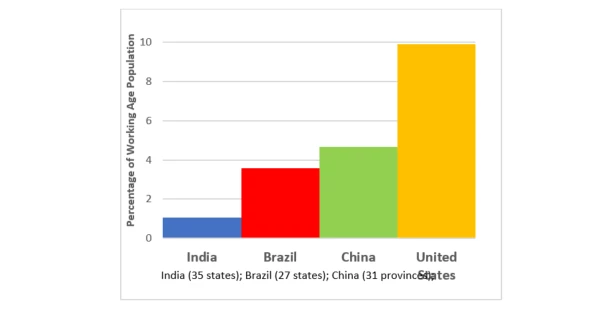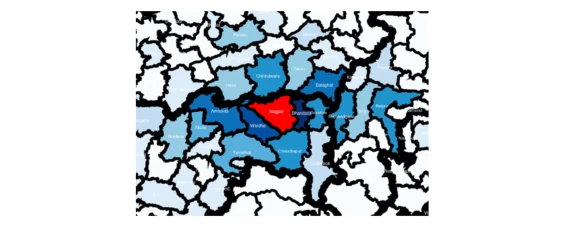That international borders limit migration is obvious. But why should provincial or state borders prevent people from moving within a country? After all, most countries do not impose restrictions on mobility like the “hukou” system in China. Yet, in an article forthcoming in the Journal of Economic Geography, we find evidence of “invisible walls” between Indian states (Kone, Zovanga Louis; Mattoo, Aaditya; Ozden, Caglar; Sharma, Siddharth. 2017). Indians, particularly men seeking education and jobs, display a puzzling reluctance to cross state borders.
On the face of it, internal migrants represented 30 percent of India’s population in 2001. But this number is deceptively large: two-thirds were migrants within districts, and more than half were women migrating for marriage. Figure 1 reveals internal migration rates across states were nearly four times higher in Brazil and China, and more than nine times higher in the United States in the five years ending in 2001. Other researchers found that in a comparison of internal migration in 80 countries, India ranked last (Bell, Charles-Edwards, Ueffing, Stillwell, Kupiszewski, and Kupiszewska 2015).
Figure 1: Inter-State Migration Flows in the Five Years Ending in 2001 (as percentage of working age population)
Working with the Indian census authorities, we obtained unique data from the latest available 2001 Census on district-to-district migration between each pair of India’s 585 districts. We examined patterns by gender, age, education, duration of stay and reason of migration.
To illustrate the restrictiveness of state borders, consider Nagpur, a district located at the center of India in Maharashtra, and close to three other states – Andhra Pradesh, Madhya Pradesh and Chhattisgarh. Figure 2 shows the origins of migrants coming to Nagpur – darker shades signifying larger shares. The thin lines represent district boundaries and the thick lines are state borders. The four neighboring districts in Maharashtra (Bhandara, Wardha, Amravati, and Chandrapur) sent a total of 31 percent of Nagpur’s immigrants. The remaining three neighboring districts in Madhya Pradesh (Balaghat, Chhindwara, and Seoni) sent a total of only 13 percent. In fact, more migrants came to Nagpur from other districts in Maharashtra hundreds of kilometers away than from neighboring districts in other states. Almost identical patterns are observed when we look at emigration from Nagpur to other districts.
Figure 2: Origins of in-migrants in Nagpur
In our analysis, we accounted for barriers to internal mobility, such as physical distance and linguistic differences between districts. We also considered differences in economic and social features. Even after controlling for these other influences, state borders still emerged as critical impediments to mobility. We found that migration between neighboring districts in the same state is at least 50 percent larger than migration between neighboring districts in different states.
Interestingly, state borders were found to be a bigger hindrance to the migration of men than of women, and for younger men of working age. The negative effect was also linked to education levels – the more educated were more reluctant to cross state lines.
India’s low level of inter-state mobility is puzzling because there are no explicit barriers. We suggest a possible explanation: the entitlement programs implemented at the state level.
First, many social benefits are not portable across state boundaries since they are administered by the state governments - even when they are federally funded. For example, access to subsidized food through the Public Distribution System (PDS), and even admission to public hospitals is administered through “ration cards,” issued and accepted only by the home state government. We find that in states where the public distribution system offers higher levels of coverage, unskilled migrants are relatively less likely to move out-of-state.
While non-portability of such benefits inhibits the movement of the poor and the unskilled, two other factors contribute to the inertia of the skilled. Many universities and technical institutes are under the control of state governments, and state residents get preferential admission. Furthermore, government jobs account for more than half of the employment opportunities for the high-skilled. A common requirement for employment in state government entities is state domicile, usually requiring long periods of continuous residence.
Sure enough, the relative share of migrants moving out-of-state to seek higher education is lower in states with higher rates of access to tertiary education. And the relative share of skilled migrants moving out-of-state is lower in states with higher rates of public employment.
Internal mobility enables the reallocation of labor to more productive opportunities across sectors and regions and is, therefore, critical for poverty reduction and growth. India’s “fragmented entitlements”–i.e. state-level administration of welfare benefits, as well as education and employment preferences– are likely to dampen growth by preventing the efficient acquisition of skills and efficient allocation of labor. The introduction of the Aadhar card, a unique national identification system will lower but not eliminate the costs of moving. Only when each Indian state treats all Indian citizens equally, will India really be on the move.
This blog was originally published on Future Development and co-authored with Zovanga L. Kone, Maggie Y. Liu, Çağlar Özden and Siddharth Sharma.






Join the Conversation